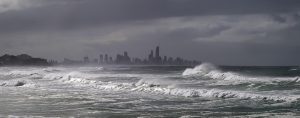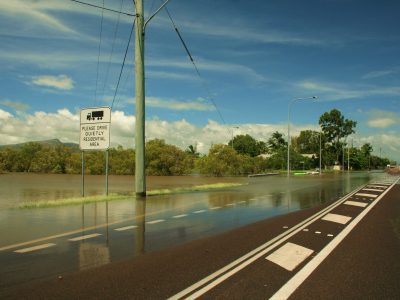Complex Disasters: Compounding, Cascading and Protracted
I recently received a copy of a book edited by Anna Lukasiewicz and Tayanah O’Donnell entitled “Complex Disasters: Compounding, Cascading and Protracted”. It was published late 2022 as part of a series by Palgrave Macmillan embracing disaster risk, resilience, reconstruction and recovery. Anna is the series editor. The series takes an “interdisciplinary integrated approach” that is deemed necessary for effective risk reduction and recovery. Particular attention is given in the series to those areas of the work that experience large scale societal and economic losses from disaster events. This book looks at Australia and other countries in its region where disaster risk policy requires a much more comprehensive examination of governance and emergency management practices that connects science and technology with communities in ways that will reduce losses from disasters.
The context for this book is the growing scientific intertest in climate-related risk issues. In 2018 a powerful multiauthor article appeared in Nature Climate Change on “Future climate risk from compound events” ( J. Zscheischler et al., NCC Perspective, 2018, https://doi.org/10.1038/s41558-018-0156-3). Here compound events are defined as the combination of processes (climate drivers and hazards) leading to significant impacts. They point out that traditional risk assessments typically consider one driver and/or hazard at a time. Processes that cause extreme events are more likely to interact and in order to avoid underestimation of risk their interdependence must be better understood. Their study seeks to provide a “bridge” between climate scientists, engineers, social scientists, impact modellers and decision makers in order to understand such complex events. In doing so they point out that “the historical record of compound events provides incomplete information on how events may occur in the future”.
Anna and Tayanah have assembled a collection of authors from a range of backgrounds reflecting the importance of the “bridge” noted above (disclosure: I am one of the 31 contributors). The book is divided into five parts comprising a total of 19 chapters. Parts include: (I) Introducing the concepts; (II) Compound risks and impacts; (III) Cascading disasters and risks; (IV) Protracted disasters and their impacts on recovery; and (V) Managing disaster complexity.
The editors in setting the scene for the book seek to clarify terms to be used, noting that complex and multiple disasters and risks are described in various ways. They frame the book around the three concepts, two that are officially recognised in official reports, compound as noted above, and cascading embracing situations where one event can trigger other events with their own impacts. Protracted disasters pick up on the phenomenon of “slow-onset” events where risk stays “in flux” for long periods. These concepts form what they term “tripartite complex disaster framing” that are occurring under evolving threats arising from climate change conditions. Generation of new knowledge about such threats requires finding new ways to translate it into policy and practice.
At this point I turn to Chapter 4 written by the late Will Steffen. Here I pay tribute to his enormous impact on development and communication of climate change science over several decades in Australia and globally. This chapter contains a clear exposition of how climate change is influencing extreme weather in Australia including reference to the ever-growing corpus of “attribution studies.” His section on compound extreme weather events with examples from recent fires and floods leads him to refer to “chains of extreme weather” with multiple impacts. Decision makers must become more alert to what he describes as “abrupt, nonlinear extreme event tipping points” (p.69). Understanding the likelihood of tipping points being reached should be built into all regional and local climate change adaptation plans. Finally, he provides an analysis of future projections with a succinct summary from his perspective of the recent 6th IPCC Assessment Report including a section on coastal erosion and flooding (p 74). His last words deserve repeating, they are so poignant: “These analyses convey a simple but powerful message—the risks of climate change are escalating rapidly and the time we have left to meet the climate change challenge effectively is running out. The choices we make now here in Australia and around the world over the next few years may well be the difference between a planet on which our children and grandchildren can survive in a reasonable state, albeit with a much more difficult climate, or a planet whose environment will become exceptionally volatile and hostile, incompatible with well-functioning human societies” (p.77).
One of the key messages that runs through several chapters of this book is how to integrate complex disaster framing into public policy and adaptation planning. Impacts of extreme events must not be seen as just one-off occurrences but as an ongoing part of everyday life. Issues of governance must therefore embrace communities. Here lies a critical issue, that of trust. As discussed by Barnes in Chapter 3, community perception of trust and credibility in government is important in disaster risk reduction. Many decisions affecting everyday life are made by entities removed from impacted locations, creating disconnects in language and understanding of events including long term effects. There is potential for communication and knowledge gaps to lead to resistance and misunderstandings at regional and community levels. Even failure to disclose in a timely manner critical information on the nature of threats may lead to mistrust as noted below.
I do not intend to comment on all the chapters; there is an excellent summary in Chapter 19 by the editors. However, there are two chapters that specifically deal with coastal disasters. Tayanah kindly invited me to co-author Chapter 5. Here we see coasts as a battleground in contested spaces in disaster preparedness, response and climate adaptation involving different public and private interests. Continued population growth and development pressures in coastal areas will produce huge adaptation challenges and there is scope for federal leadership, partnerships and coordination in public policy initiatives in disaster preparedness. Sonia Graham in Chapter 7 focusses on the individual attachment to place in the context of compound risks of sea level rise and areas exposed to other climate change hazards such as bushfires. This study arises from detailed human geography research in east Gippsland. She demonstrates how climate change research would benefit from more engagement in regional locations where residents may spread their activities across multiple places.
One of the key messages that emerges from papers in this book is the need for more transparent governance associated with clear and open communication as we prepare for and respond to compound, cascading and protracted disasters exacerbated by climate change. This applies not just to what will be part of everyday life in Australia but also in our region. Sadly, this is not always evident. Chris Barrie and Ian Dunlop have just published in Reneweconomy.com.au (5 April 2023 (reproduced in Pearls and Irritations 6/4/23) an article entitled “The government has a duty to be transparent about all security risks”. They point to recent work by the Office of National Assessment (ONI) on climate risk assessment which addressed external not domestic climate threats. This work has not been made public unlike assessments made in the UK which concluded that risks are compounding especially for food security. Barrie and Dunlop argue that we need to know what the findings of ONI are “in order to adequately prepare and respond”. The federal government must be open and transparent about the magnitude of climate change threats. Otherwise given our recent experience with pandemics, fires and floods, we will suffer the consequences of underestimating the likely size of future events. One can only hope that the Defence Strategic Review released this week will contribute to more transparency on climate change security threats. As we see from those who have contributed to the book on Complex Disasters, the nature of risks we face requires greater degrees of engagement and transparency to improve levels of trust in the decisions that must be made at all levels of society.
Bruce Thom
Words by Prof Bruce Thom. Please respect the author’s thoughts and reference appropriately: (c) ACS, 2023. For correspondence about this blog post please email admin@australiancoastalsociety.org.au
#238



 Coasts and Climate Change – Don Wright’s Perspective
Coasts and Climate Change – Don Wright’s Perspective